|
The Exotic New World
of Designer Toys
by Bob Brooke
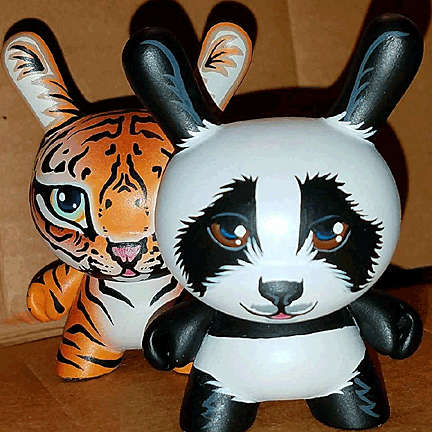 Chances
are you’ve never heard of designer toys. Ask around, you probably won’t
find anyone else who has heard of them, either. But they’re out there
waiting to be collected. As one of the newest collectibles, designer
toys are on the cutting edge. Collectors comprise a very knowledgeable
in-crowd of all ages who frequent “DCONs”—designer conferences—that are
popping up all over the country. Like their sister conferences—the more
well known “COMICONs,” made popular through the hit T.V. show “Big Bang
Theory,” they attract an eclectic group of collectors looking for
anything new and different. Chances
are you’ve never heard of designer toys. Ask around, you probably won’t
find anyone else who has heard of them, either. But they’re out there
waiting to be collected. As one of the newest collectibles, designer
toys are on the cutting edge. Collectors comprise a very knowledgeable
in-crowd of all ages who frequent “DCONs”—designer conferences—that are
popping up all over the country. Like their sister conferences—the more
well known “COMICONs,” made popular through the hit T.V. show “Big Bang
Theory,” they attract an eclectic group of collectors looking for
anything new and different.
And designer toys are certainly different.
What are Designer Toys?
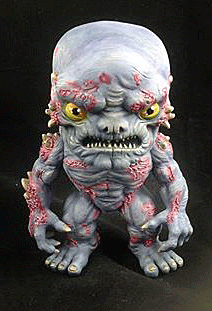 Designer
toys are a modern art form more or less based on manufactured forms, but
not necessarily. And just like any definition of art, the answer lies
very much in the spirit of "art is in the eye of the beholder.” And
while the term designer toys primarily covers original artist creations,
it doesn't necessarily exclude licensed properties. So while the world
of designer toys may be a bit complicated to understand, the common
thread throughout is an emphasis on the artist or designer behind the
"toy," whether it’s a one-of-a-kind or a manufactured series. Designer
toys are a modern art form more or less based on manufactured forms, but
not necessarily. And just like any definition of art, the answer lies
very much in the spirit of "art is in the eye of the beholder.” And
while the term designer toys primarily covers original artist creations,
it doesn't necessarily exclude licensed properties. So while the world
of designer toys may be a bit complicated to understand, the common
thread throughout is an emphasis on the artist or designer behind the
"toy," whether it’s a one-of-a-kind or a manufactured series.
Designer toys have become known by many names—art toys, toy art, urban
toys, urban vinyl, vinyl toys, and designer plush, to name a few. These
are artistic toys. For artist
Heath
Duntz of St. John, Kansas, they’re more art than toys. Just like
any painter or sculptor, Duntz takes great pride in his work and his
craftsmanship. And so do fellow artists
Richard Strohmeyer,
of St. Paul, Minnesota,
Marshall Ballantyne of Englewood, Colorado, and
Alexis Rivera of Philadelphia, who like Duntz, spend long hours
perfecting their creations.
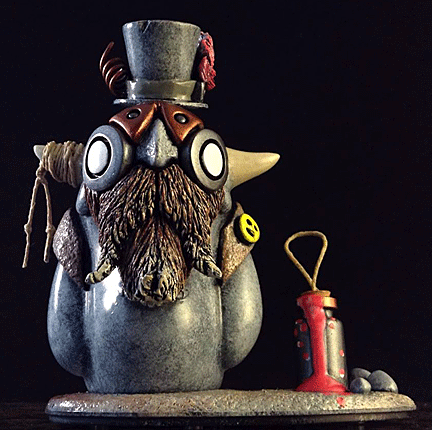 The
term “vinyl toys” specifically links back to the birth of the art form
in 1995 with Michael Lau's Gardener figures. The fine art world dubbed
this new form “toy art” to describe a new art form with which many
collectors were unfamiliar. The
term “vinyl toys” specifically links back to the birth of the art form
in 1995 with Michael Lau's Gardener figures. The fine art world dubbed
this new form “toy art” to describe a new art form with which many
collectors were unfamiliar.
The culture which fostered collecting designer toys began with the
Star Wars action figures. But George Lucas and toy manufacturer
Kenner made this into a multi-million dollar mass-production business.
Young artists realized his success and wanted to do something of their
own. In George Lucas’ Star Wars universe, each character had a name, a
story, and a marketed toy. Whether you’re a Star Wars fan or not, these
marketing techniques influenced the way people think about collecting
these little plastic toys today.
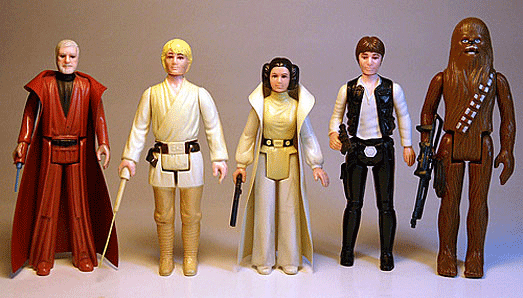
Though mainstream Star Wars figures aren’t considered art, they are
mass-produced licensed properties. Designer toys, however, don’t
necessarily refer to licensed properties because the toys, themselves,
aren’t the original creation of an artist. And while someone did create
the Star Wars figures, that designer became just another part of the
process. In designer toys, the artist is the most important part of the
process.
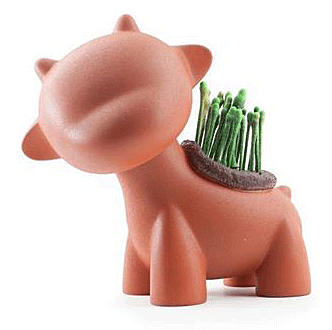 A
wide assortment of objects can fall under the designer toy umbrella.
Basically, a designer toy is any toy that’s sold based on the name and
direct authorship of the artist. A
wide assortment of objects can fall under the designer toy umbrella.
Basically, a designer toy is any toy that’s sold based on the name and
direct authorship of the artist.
Designer toys are almost always limited. Sometimes they’re a single,
hand-painted piece, sold in a gallery or auction. This piece, which an
artist treated like a blank canvas and crafted something new upon it, is
known as a custom. Usually, a custom piece is one-of-a-kind and can even
be used as the blueprint for a more widely released figure.
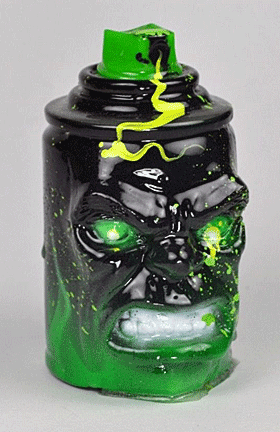 Also
included under the designer toy umbrella are some small-run toys. Often
artists craft these of resin, produce only a set number, and sometimes
sign them. They make them by hand with a high attention to detail. Also,
some mass-produced ones can be considered designer toys and are usually
made from vinyl. Intended for display rather than play, they’re fairly
affordable, and though they’re usually limited, they have a higher
number of items produced compared to other designer toys. What keeps
these toys in the realm of art is still the artist, who’s still the
central voice in the design. Also
included under the designer toy umbrella are some small-run toys. Often
artists craft these of resin, produce only a set number, and sometimes
sign them. They make them by hand with a high attention to detail. Also,
some mass-produced ones can be considered designer toys and are usually
made from vinyl. Intended for display rather than play, they’re fairly
affordable, and though they’re usually limited, they have a higher
number of items produced compared to other designer toys. What keeps
these toys in the realm of art is still the artist, who’s still the
central voice in the design.
With designer toys, it's all about the artist's vision and what they can
create within the constraints of the material. Artists use a variety of
materials, such as ABS plastic, vinyl, wood, metal, latex, and resin.
Some designer toys are plush toys. Creators often have backgrounds in
graphic design, illustration or self-described low brow art while some
have classical art and design training. Others are self-taught.
Custom Designer Toys
A custom designer toy is a readymade. In this case, an artist takes an
ordinary found object and alters it to present it as a work of art. In
the case of designer toys, readymades are known as “platforms”—a basic
manufactured form to which they can add ornamentation or sculpt into
something original.
Custom toys come in two varieties—an existing toy which is customized to
become something new and a basic, and a blank, do-it-yourself platform
used as a canvas to create a new work of art.
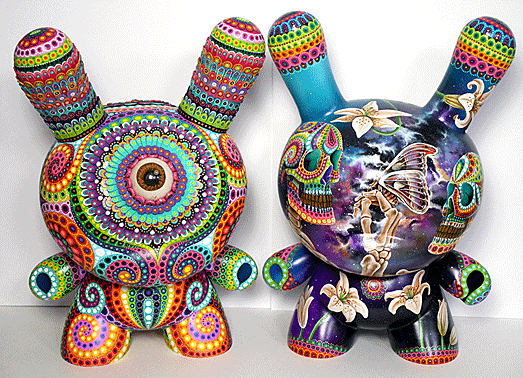
The process is quite simple. An artist, such as MP Gautheron of Lyon,
France, takes an existing toy and
modifies it to make it their own. Much like a stretched canvas provides
a platform for a painter, the platform toy provides the blank canvas for
the toy artist. The process of customizing an existing toy can include
painting the figure, adding sculptural elements, or taking away parts to
alter its appearance.
Two of the more popular platforms to customize are the Dunny series and
a variation of the Dunny known as the Munny.
The Dunny Series
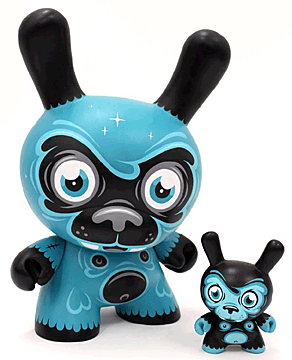 One
of the most prominent platforms is the Dunny series, vinyl toy figures
created by Paul Budnitz and Tristan Eaton and produced by the American
company Kidrobot in 2004. These cute little figures resemble
anthropomorphized rabbits with distinctive tubular ears—a design
originally illustrated by graffiti, stencil, and comic artists—which
come in 3-, 8-, and 20-inch sizes, although artists have customized
Dunny models as tall as four feet. The toy has three points of
articulation—a 360-degree rotational head and two arms. It’s name comes
from a combination of street slang and one of the early "Devil Bunny"
prototypes. One
of the most prominent platforms is the Dunny series, vinyl toy figures
created by Paul Budnitz and Tristan Eaton and produced by the American
company Kidrobot in 2004. These cute little figures resemble
anthropomorphized rabbits with distinctive tubular ears—a design
originally illustrated by graffiti, stencil, and comic artists—which
come in 3-, 8-, and 20-inch sizes, although artists have customized
Dunny models as tall as four feet. The toy has three points of
articulation—a 360-degree rotational head and two arms. It’s name comes
from a combination of street slang and one of the early "Devil Bunny"
prototypes.
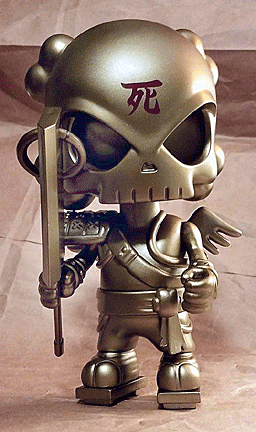 A
variation of the Dunny figure is the Munny, vinyl figures with movable
joints produced by Kidrobot, which resembles a monkey, and is only sold
as an unpainted do-it-yourself figure. It’s chubby, humanoid blank shape
provides artists with endless options and variations, using pens,
pencils, markers, or paint. Alternatively, some people commission
artists to design Munnys for them, or artists design them to sell. The
original Munny is white, stands 7 inches tall, and weighs about 1 pound
while a micro Munny stands 2 inches tall and a mega munny at 18 inches. A
variation of the Dunny figure is the Munny, vinyl figures with movable
joints produced by Kidrobot, which resembles a monkey, and is only sold
as an unpainted do-it-yourself figure. It’s chubby, humanoid blank shape
provides artists with endless options and variations, using pens,
pencils, markers, or paint. Alternatively, some people commission
artists to design Munnys for them, or artists design them to sell. The
original Munny is white, stands 7 inches tall, and weighs about 1 pound
while a micro Munny stands 2 inches tall and a mega munny at 18 inches.
However, Kidrobot’s Dunny and Munny aren’t the only platform toys out
there. The now defunct HuckGee’s The Blank is another widely popular
form.
Other Forms of Customizing
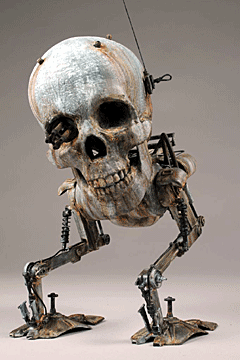 Another
form of customizing is “kitbashing,” a technique used by model
railroaders to create buildings from pieces that come from different
model kits. In this case, some designer toy artists use pieces from
model kits to produce art toys. Another
form of customizing is “kitbashing,” a technique used by model
railroaders to create buildings from pieces that come from different
model kits. In this case, some designer toy artists use pieces from
model kits to produce art toys.
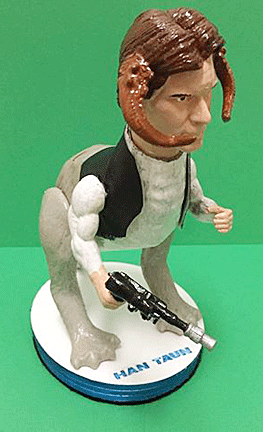 Still another is a “mashup,” which combines two characters, two genres,
or two opposites, paroding popular culture. Artist
Jeremy Bourquin uses this technique. Taking two Star Wars
figures, Hans Solo and the Tauntaun, and combining them to produce a new
form, the Hantaun. Still another is a “mashup,” which combines two characters, two genres,
or two opposites, paroding popular culture. Artist
Jeremy Bourquin uses this technique. Taking two Star Wars
figures, Hans Solo and the Tauntaun, and combining them to produce a new
form, the Hantaun.
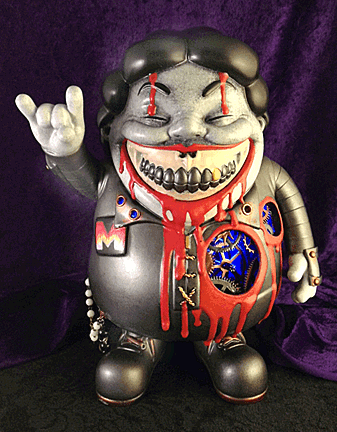 And
yet another is the “x-ray, where an artist cuts into a platform toy,
such as a Ronald McDonald and shows its workings inside. Artist Heath
Duntz often uses old clock and watch gears and parts but others show
part of the toy's skeleton. And
yet another is the “x-ray, where an artist cuts into a platform toy,
such as a Ronald McDonald and shows its workings inside. Artist Heath
Duntz often uses old clock and watch gears and parts but others show
part of the toy's skeleton.
Though custom toys are usually one-of-a-kind, an artist may create
multiples by handcrafting the same design in a series, making minor
alterations to each piece, sometimes as simple as changing its color.
Resin toys
Some artists create their toys using synthetic resin material and resin
casting. After casting, the resin toy receives adjustments in its
details, sometimes being superficially cast on some parts. The toy can
be finished using aerosol automotive paint and sometimes receives a
varnished layer over the paint layer.
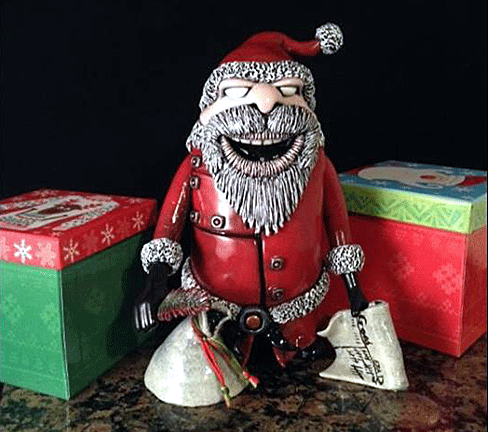
Resin casting allows artists to produce toys in small numbers. Most
vinyl factories will only produce toys in large series. Resin toys have
become a way for up-and-coming artists to produce a toy without the
large financial investment required to produce a vinyl toy. Unlike most
vinyl toys, resin toys are usually sculpted, cast, and painted by a
single artist. Sometimes, a commercial company like Kidrobot will make a
deal with an artist to produce his or her toy in vinyl for the mass
market.
Designer Plush
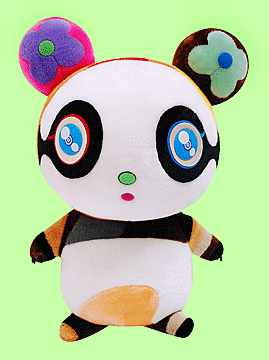 A
subcategory of designer toys is Designer Plush, consisting of soft,
stuffed dolls created in limited quantities by artists and designers.
Common designs include anthropomorphized animals or fantastic human
likenesses, although designer plush dolls often feature entirely unique
character designs. Designer plush dolls are usually given names and
personas, with their distinctive personalities described on their tags
or in booklets included in their packaging. A
subcategory of designer toys is Designer Plush, consisting of soft,
stuffed dolls created in limited quantities by artists and designers.
Common designs include anthropomorphized animals or fantastic human
likenesses, although designer plush dolls often feature entirely unique
character designs. Designer plush dolls are usually given names and
personas, with their distinctive personalities described on their tags
or in booklets included in their packaging.
Blind Boxes
The McDonald’s Happy Meal has always has always been a way for kids to
get a toy. The excitement on kids’ faces in the anticipation of getting
the toys they want is much like that on adult collectors’ faces as they
anticipate getting the small designer toy they want from a “blind box.”
And if collectors don’t get the toy they desire, they know they can try
again and again until they do. Many collectors buy an entire set of
blind boxes, usually 12, that possibly contain the toy they want. The
set can cost several hundred dollars. Then they sell the pieces from the
set that are duplicates of what they already have. The mystery, the
anticipation, the joy, and even the disappointment are all part of what
makes collecting blind boxes so exciting—and so popular.
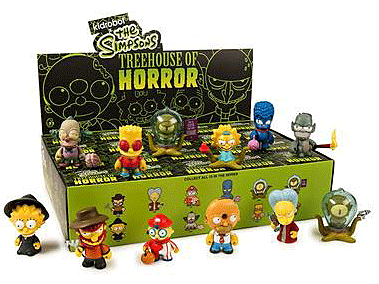 Blind
boxing is a popular way of selling small designer toys. Blind packaging
has been around for some time. But not all the toys in a particular box
of blind boxes have the same rarity. Those that are less available than
others in the set are known as “chase” figures. Often an unnamed
silhouette represents a chase figure’s design. Plus, the chase figure
may not even be in a particular set. Blind
boxing is a popular way of selling small designer toys. Blind packaging
has been around for some time. But not all the toys in a particular box
of blind boxes have the same rarity. Those that are less available than
others in the set are known as “chase” figures. Often an unnamed
silhouette represents a chase figure’s design. Plus, the chase figure
may not even be in a particular set.
A good example of a blind box series are Kidrobot’s series of Dunnys
such as "The Simpsons: Treehouse of Horror." The boxes are all exactly
the same, so collectors have no idea what’s inside.
With designer toys, there’s a close relationship between the artist and
the collector, unlike collecting regular art in which the collector
purchases works of art but normally doesn’t have a personal relationship
with the artist. And just as in the realm of collecting baseball or
other cards, trading and reselling are all part of the community feature
of the designer toy world.
< Back
to Collectibles Archives Next
Article >
|
